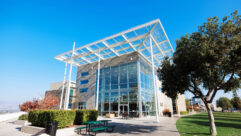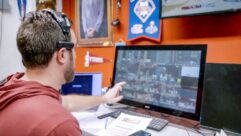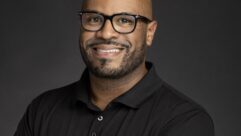
Suffolk County Community College Goes Digital
Jul 16, 2008 12:00 PM,
By Linda Seid Frembes

At its recently unveiled Digital Television Studio Complex, Suffolk County Community College (SCCC) in Selden, N.Y., is well on its way to fulfilling a three-year digital-technology-upgrade plan. The two-year college is nationally known for its advanced radio and television production program, which was founded in 1968. In 40 years, SCCC has graduated more than 800 students and counts five television network-level vice presidents among its prestigious alumni.
The production program is led by Alan Bernstein, a professor of radio and television production as well as the assistant academic chair for the school’s Department of Communications/Radio/TV/Film. “The program is constantly hands-on from day one. The goal is that students are not afraid of equipment. My students are ready to work when they graduate. They learn the right work ethic or they don’t make it,” says Bernstein, who still works in television sports, has won three national Emmy awards with NBC and has covered four Olympic Games. “Our students graduate with more hands-on experience than most students at four-year universities.”
SCCC has invested heavily in current technology to ensure that students achieve a high level of knowledge and experience, including a total rewiring of the studio for the switch to full digital capability. The 30’x40′ studio features a professional lighting rig, a digital audio mixing console, HD-ready JVC GY-HD250U cameras, 15 Apple Final Cut Pro editing stations, and a new Echolab 1-M/E Overture1 switcher. The school worked with Adwar Video, an AV reseller in Farmingdale, N.Y., to acquire the Overture1 system.
As with many education budgets, equipment choices for SCCC’s studio is a compromise between cost and performance. “We had an Echolab DV5, and it worked without a glitch for 10 years,” Bernstein says, explaining why he chose to look at Echolab products again. “The most attractive feature on the Overture1 switcher is the floating frame synchronization. There are no timing or shift errors; it literally syncs with everything. It is simple to teach on a basic level. In a teaching facility, ease of equipment operation leads to a better learning curve, and that’s just what Echolab’s switching solutions have provided for our students.”
1
Suffolk County Community College Goes Digital
Jul 16, 2008 12:00 PM,
By Linda Seid Frembes
SCCC upgraded to a 1-M/E Overture1 system due, in part, to the switcher’s advanced functionality and feature set—including a greater number of keyers, new DIP and DVE transitions, the SuperSource layering engine, and the aforementioned floating frame synchronization. Echolab’s Overture1 combines internal conversion and synchronization with powerful key layering and special effects to provide simple control over complex production tasks and, in turn, streamline creation of a sophisticated on-air look. Overture switchers accept up to 32 multiformat analog and digital signals and provide as many as 16 multiformat outputs. Internal frame synchronization helps to ensure the quality of effects, and integrated up-/crossconversion within MD models streamlines switching of video in multiple formats.
In addition, Echolab’s Stinger transition is a special “take block” keyer with combined mix/wipe and graphic control that reduces complex animated transitions to a single button press. The Overture switchers’ new SuperSource allows the operator to build a custom layout using DVEs and graphics and then assigns the composition to a crosspoint button. A DVE key in each take block enables instant transition effects, and the MD Overture systems offer as many as four channels of DVE with warp and lighting effects. DVE capabilities are complemented by as many as 34 internal graphics/still stores.
“The Echolab switcher provides the most flawless transitions you could ever imagine, and it has several times the power of any production switcher we’ve had here at our facility,” Bernstein says. “Our students find it easy to learn switching techniques on the very capable Overture1 switcher, and they leave our program with the skills and confidence to work with any type or size of switcher they encounter in their professional work.”
Another dose of real world exposure comes from a generous alumni donation in the form of equipment from the former control room of WGBH, a public television station in Boston. SCCC alumni David Haralambou, president of By Request Communications, bought the equipment prior to WGBH’s move to a new facility and donated it to the school. Bernstein is very proud to point out that their production control room rivals that of nearby New York University.
Current and future plans for SCCC’s production program include the transition to a tapeless system both inside and outside the studio. In the field, the school is using JVC cameras outfitted with optional 100GB hard drives. According to Bernstein, there are three JVC GY-HD200UB cameras, two GY-5000 cameras that are hard-drive-adaptable, and several GY-110 cameras with hard drives. Next year, the school will install a production server for the studio so that everything that is recorded will be tapeless.
2










